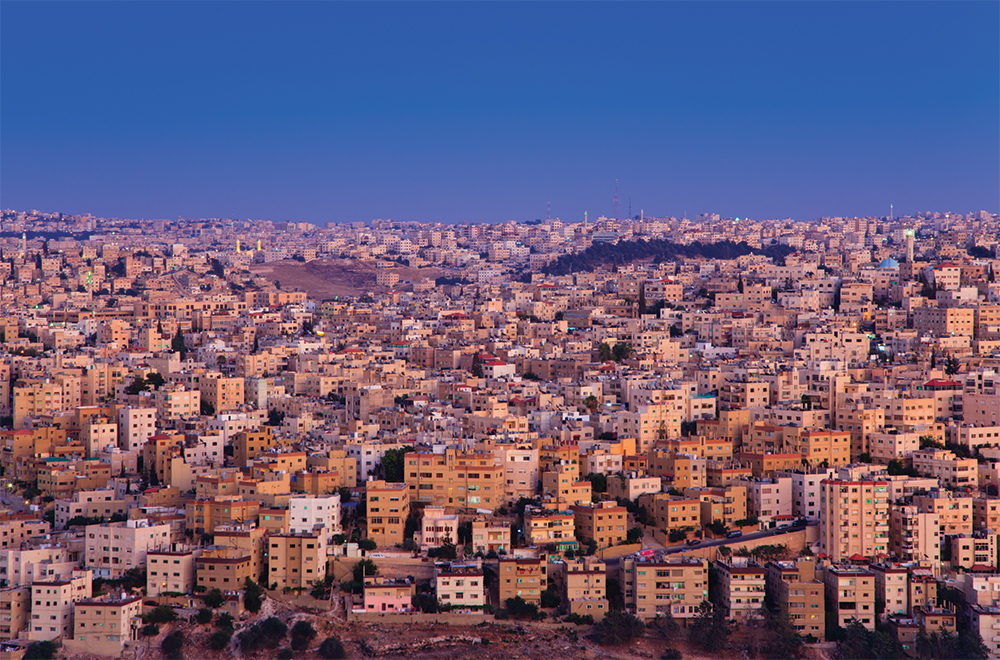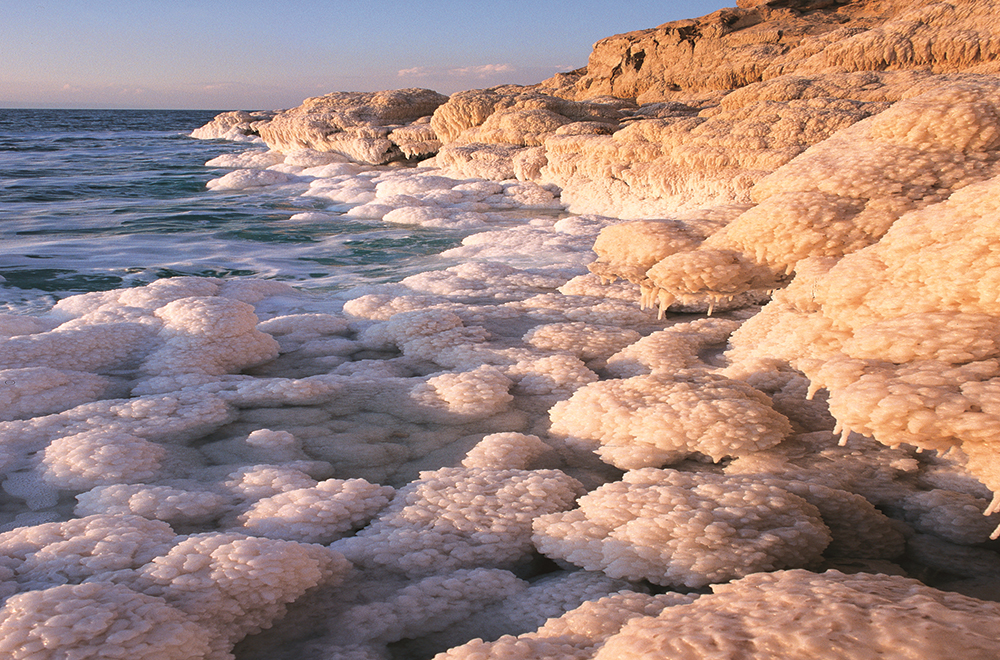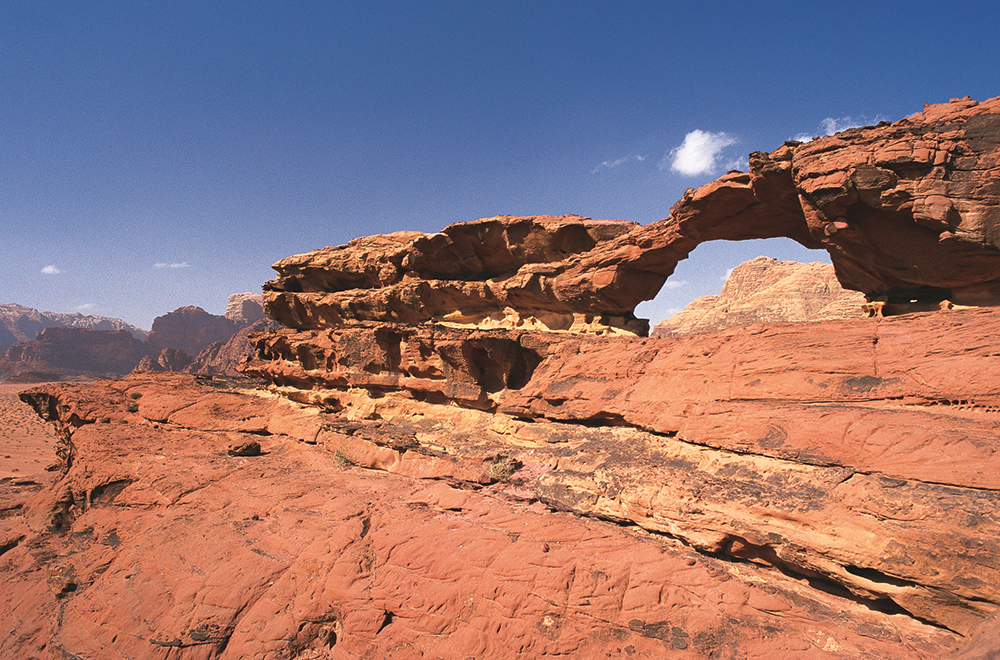
What do the movies Indiana Jones and the Last Crusade and The Martian have in common? Separated by 25 years, the former, a historical adventure blockbuster, features ancient temples tucked away between red canyons, whereas the sci-fi latter showcases a vast, alien land of nothing but sand. The answer? They were both filmed in the magnificent country of Jordan.
Though many have heard of the country’s most famous attraction, Petra – which consists of a series of temples and ancient ruins dotted around its valleys – most people are unfamiliar with this Middle Eastern gem and the rich cultural experiences it has to offer.
Unless you travel by car from Israel – and whether border crossings are permissible tends to change often, so plan accordingly – most people arrive in Jordan by air and land in the capital city of Amman. Right in the city centre, you’ll see an ancient Roman amphitheatre; a short climb up its steps will reveal a sharp contrast between the historical landmark where you stand and the hustle and bustle that surrounds it.Once you’ve rested up and have had the chance to visit the amphitheatre, make your way down south, because that’s where the real adventure begins – and where the crux of Jordan lies. A drive of about an hour takes you to Mount Nebo, where it’s written in the Hebrew Bible that Moses saw the Promised Land. Aside from the majestic panoramic views of the mountains, you can also marvel at the ancient mosaic paintings.
The drive south continues and about an hour later, you’ll reach the Dead Sea. Even before you’ve sighted it, you’ll smell the salt in the air – distinct from any other ocean breeze that you may be accustomed to. Once you get to the coastal area, you can arrange a relaxing overnight stay at one of the resorts there, then spend the afternoon floating around the Dead Sea – a once-in-a-lifetime sensation. (Top tip: Don’t get overly excited and swallow any liquid when you first ease yourself into the black water.) From here, you can actually see Israel and the Palestinian territories.

After the Dead Sea, if time allows and you’re up for a vigorous workout, stop by Wadi Mujib and try the canyoning. Start near the Mujib Bridge, where you can either go on a moderate self-guided trail or sign up for one of the more difficult guided adventures. You’ll experience the spectacular canyons in this area by treading up the river, abseiling, jumping down waterfalls and sliding down rapids – be sure to stretch out first.
A scenic drive for about three hours on the Jordan Valley Highway – and be sure to stop by Karak Castle along the way for its panoramic views of the valleys – will take you to the country’s most famous tourist attraction, Petra. Deserving of its reputation, the southern Jordanian city was crowned one of the New Seven Wonders of the World and has been declared a Unesco World Heritage Site. With more than 4,000 years of history, Petra is an important archaeological and historical place. Half-built, half-carved and nestled in the red sandstone gorges and mountains, it was also known as the Lost City. This former trading centre and capital for the Nabataeans has loads of interesting things to see and do; it’s worth at least two or three days of your trip.

Once you pass the Siq – the main entrance to Petra, which is a narrow gorge – you’re immediately drawn to a more open space that contains the most famous monument, Al-Khazneh (or the Treasury). It’ll have you craning your neck to appreciate its sheer size – and you’ll marvel at the unimaginable skills it would have taken the Nabataeans in ancient times to carve this masterpiece out of the sandstone rock. After admiring the Treasury, take your time to explore the plethora of tombs, temples, halls and theatres dotted around the valleys that stretch for about 4km.
On your second day, take a short 40-minute hike from the Nabataean Museum and be prepared to be awestruck again by another main attraction in the ancient city: the Monastery. Also known as Al-Deir, it’s perched high on the hills, offering a different sense of magnificence compared to the Treasury. Just a few steps further to the cliff’s edge will offer panoramic views of “the End of the World” over southern Jordan, Israel and the Palestinian territories. Take a break at the nearby tea shop, tucked away in a cave and a great spot to rest your legs while admiring the Monastery.

After Petra, continue your journey south to Wadi Rum: the Valley of the Moon. The largest desert in Jordan, Wadi Rum covers 720sqkm (which stretches into Saudi Arabia) and is another Unesco World Heritage Site. Here, the vast red-brick sand and surrounding cliffs will whisk your mind away to the days of Lawrence of Arabia, or into the future as Mark Watney, the astronaut left alone on Mars in The Martian. Experience the full Wadi Rum wilderness by organising an overnight stay at one of the Bedouin camps. They’ll bring you from the nearby village in a Jeep and take you around Wadi Rum to see the prehistoric rock paintings in the valleys. After that, the ATVs or Jeeps will soar through the desert – a fun and manageably bumpy ride – as you pass wild camels on your way to the camp, where you can admire an unforgettable sunset against layers after layers of red sand.

At the Bedouin camp, you’ll be served a delicious dinner in a beautiful tent with handwoven carpets and colourful cushions. Music, singing and dancing follows, with the Bedouins sharing stories about how they have lived in the area for centuries. While the tent is warm and welcoming, do venture outside for some solitude and stargazing – you will be able to see countless stars and even shooting stars regularly in Wadi Rum.
While glamping isn’t a thing in Wadi Rum and the camp facilities are somewhat basic (with only cold showers and squat toilets – after all, it is in the middle of a desert), it’s an utterly unique experience to live like the nomads in such a tranquil, gorgeous setting. For those who are feeling a bit more adventurous, opt for what we did and sleep in a semi-open cave rather than the pre-set tents. After dinner, the camp staff drives you to a remote location, where you’ll sleep next to a rock cliff without a roof above your head, under the supervision of the stars and the moon. The Bedouin camp staff may even stay for a while, where they’ll share stories by the campfire and sing you a lullaby under the starlit sky.
After a good night’s sleep under the stars, we woke up feeling absolutely refreshed and calm as the morning sun rose and reflected off the rocks with a reddish glow, making our surroundings more and more vibrant. In such a naturally opulent, remote setting, without the urban necessities of air-conditioning, curtains or a roof over your head, you’ll truly appreciate what it is to be alive.
This article originally appeared in the December 2017 print issue of #legend magazine





